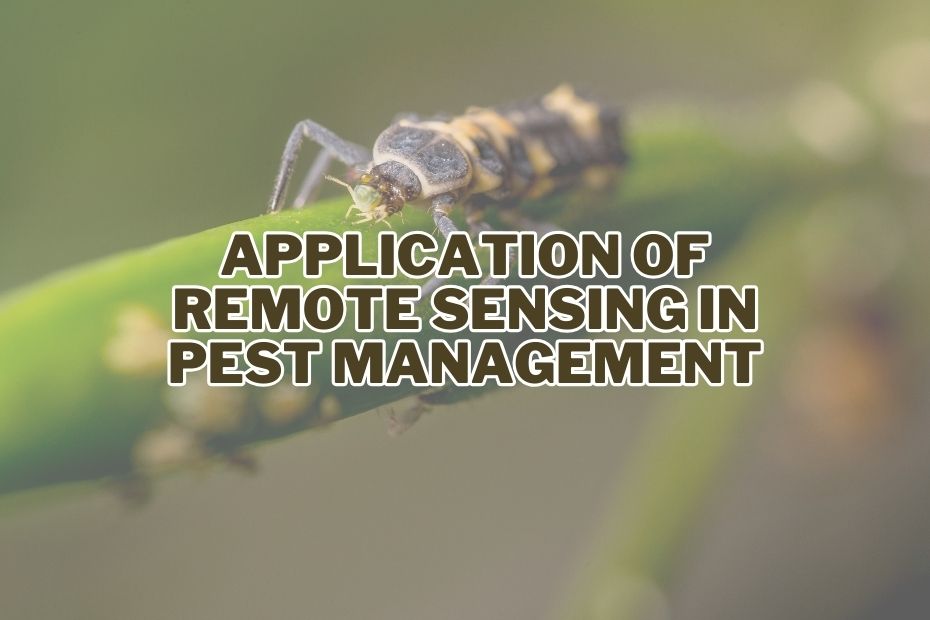Pest infestations have long been a bane for agriculture, posing a significant threat to crop yields and food security. Traditional pest management methods often prove to be resource-intensive, time-consuming, and sometimes ineffective. However, with the advancements in technology, specifically remote sensing, a revolutionary change has occurred in the way we combat pests in agriculture. This article delves into the various aspects of the application of remote sensing in pest management and how it has become a game-changer in safeguarding our crops.
Remote sensing in pest management involves using satellite or drone imagery to detect pest infestations early, monitor pest populations, and assess damage to crops. By analyzing these images, farmers can pinpoint affected areas, enabling targeted treatments and reducing pesticide use. This method improves efficiency and sustainability in agriculture.
Application of Remote Sensing In Pest Management
Ever tried to find the source of an annoying leak in your house? It’s often not where you think it is. Similarly, detecting pests in a vast farmland can be like finding a needle in a haystack. Enter remote sensing – our modern-day superhero in the world of agriculture. But, how does it help with pests? Let’s delve in!
1. Early Detection of Pest Infestations
Early detection is the first line of defense against pest infestations. Remote sensing, with its ability to capture high-resolution imagery of large agricultural areas, plays a pivotal role in this aspect. Satellites equipped with remote sensing sensors can identify subtle changes in vegetation health caused by pest attacks. By analyzing these changes, experts can pinpoint potential trouble spots, enabling farmers to take timely action.
2. Monitoring Pest Population Dynamics
Understanding the dynamics of pest populations is crucial for effective pest management. Remote sensing facilitates continuous monitoring of pest populations by capturing data on pest movement and distribution. This data assists in predicting pest outbreaks and devising strategies to control them, minimizing the need for broad-spectrum pesticides.
3. Assessing Crop Damage from Pest Attacks
Remote sensing provides a bird’s-eye view of crop fields, making it easier to assess the extent of damage caused by pests. By analyzing multispectral data, experts can precisely determine the areas affected by pest infestations. This information aids in making informed decisions about targeted pest control measures.
4. Pest Habitat Identification
Pests thrive in specific environmental conditions. Remote sensing helps identify these conducive habitats by analyzing factors like temperature, humidity, and vegetation cover. This information guides farmers in implementing preventive measures, such as altering planting dates or using resistant crop varieties.
5. Targeted Pesticide Application
One of the significant advantages of remote sensing in pest management is its ability to enable targeted pesticide application. Instead of blanket spraying, which is harmful to the environment and costly, remote sensing data allows for precise pesticide application only in the areas where it’s needed. This reduces chemical usage, minimizes environmental impact, and cuts down on operational costs.
6. Soil Health Monitoring for Pest Prevention
Healthy soil is essential for robust plant growth and resilience against pests. Remote sensing can assess soil conditions by analyzing soil moisture, nutrient levels, and temperature. This information helps farmers optimize soil health and create conditions less favorable for pests.
7. Weather Prediction and Pest Outbreaks
Weather conditions greatly influence pest outbreaks. Remote sensing plays a role in weather prediction by monitoring meteorological parameters. By integrating weather data with pest population dynamics, experts can forecast potential pest outbreaks, allowing farmers to prepare in advance.
8. Predictive Analysis for Future Outbreaks
Remote sensing data, when combined with machine learning and predictive analytics, can forecast future pest outbreaks with remarkable accuracy. This proactive approach empowers farmers to take preventive measures and reduce the reliance on reactive pest control methods.
9. Post-Treatment Analysis
After implementing pest control measures, it’s essential to assess their effectiveness. Remote sensing aids in post-treatment analysis by tracking changes in crop health and pest populations. This data helps refine pest management strategies for future seasons.
10. Quantifying the Impact on Crop Yield
Ultimately, the goal of pest management is to protect crop yield. Remote sensing allows for the quantification of the impact of pest control measures on crop production. This data-driven approach ensures that pest management strategies are optimized for maximum yield protection.
Conclusion:
In conclusion, the application of remote sensing in pest management is a transformative development for agriculture. It empowers farmers and experts with valuable data and insights that enhance the efficiency and sustainability of pest control efforts. By harnessing technology, we can protect our crops, reduce environmental impact, and ensure food security for a growing global population.
FAQs: Application of Remote Sensing In Pest Management
How does remote sensing detect early signs of pest infestations?
Remote sensing uses high-resolution imagery to capture subtle changes in vegetation health caused by pests. These changes are analyzed to identify trouble spots early.
How does remote sensing aid in targeted pesticide application?
Remote sensing data enables precise pesticide application only in affected areas, reducing environmental impact and operational costs.
Can remote sensing predict future pest outbreaks?
Yes, when combined with machine learning and predictive analytics, remote sensing can forecast future pest outbreaks with high accuracy.
Why is post-treatment analysis essential in pest management?
Post-treatment analysis assesses the effectiveness of pest control measures and helps refine strategies for future seasons.
How does remote sensing quantify the impact on crop yield?
Remote sensing allows for the measurement of the impact of pest control measures on crop production, ensuring optimized strategies for yield protection.
Can remote sensing replace traditional pest management methods?
Not replace, but it can complement traditional methods, making them more efficient and effective.
